MYH1
| MYH1 | |||||||||||||||||||||||||||||||||||||||||||||||||||
|---|---|---|---|---|---|---|---|---|---|---|---|---|---|---|---|---|---|---|---|---|---|---|---|---|---|---|---|---|---|---|---|---|---|---|---|---|---|---|---|---|---|---|---|---|---|---|---|---|---|---|---|
 | |||||||||||||||||||||||||||||||||||||||||||||||||||
| Identifiers | |||||||||||||||||||||||||||||||||||||||||||||||||||
| Aliases | MYH1, HEL71, MYHSA1, MYHa, MyHC-2X/D, MyHC-2x, myosin, heavy chain 1, skeletal muscle, adult, myosin heavy chain 1 | ||||||||||||||||||||||||||||||||||||||||||||||||||
| External IDs | OMIM: 160730; MGI: 1339711; HomoloGene: 133718; GeneCards: MYH1; OMA:MYH1 - orthologs | ||||||||||||||||||||||||||||||||||||||||||||||||||
| |||||||||||||||||||||||||||||||||||||||||||||||||||
| |||||||||||||||||||||||||||||||||||||||||||||||||||
| |||||||||||||||||||||||||||||||||||||||||||||||||||
| |||||||||||||||||||||||||||||||||||||||||||||||||||
| |||||||||||||||||||||||||||||||||||||||||||||||||||
| Wikidata | |||||||||||||||||||||||||||||||||||||||||||||||||||
| |||||||||||||||||||||||||||||||||||||||||||||||||||
Myosin-1, also known as 'striated muscle myosin heavy chain 1', is a protein that in humans is encoded by the MYH1 gene.[5][6] This gene is most highly expressed in fast type IIX/D muscle fibres of vertebrates and encodes a protein found uniquely in striated muscle; it is a class II myosin with a long coiled coil tail that dimerizes and should not be confused with 'Myosin 1' encoded by the MYO1 family of genes (MYO1A-MYO1H). Class I MYO1 genes function in many cell types throughout biology and are single-headed membrane-binding myosins that lack a long coiled coil tail.
Function
Myosin is a major contractile protein that converts chemical energy into mechanical energy through the hydrolysis of ATP. Class II Myosins are hexameric proteins composed of a pair of myosin heavy chains (MYH) and two pairs of nonidentical light chains. Myosin heavy chains are encoded by a multigene family. In mammals, at least ten different myosin heavy chain (MYH) isoforms have been described from striated, smooth, but rarely in non-muscle cells. These isoforms show expression that is spatially and temporally regulated during development.[6]
References
- ^ a b c GRCh38: Ensembl release 89: ENSG00000109061 – Ensembl, May 2017
- ^ a b c GRCm38: Ensembl release 89: ENSMUSG00000056328 – Ensembl, May 2017
- ^ "Human PubMed Reference:". National Center for Biotechnology Information, U.S. National Library of Medicine.
- ^ "Mouse PubMed Reference:". National Center for Biotechnology Information, U.S. National Library of Medicine.
- ^ Leinwand LA, Saez L, McNally E, Nadal-Ginard B (June 1983). "Isolation and characterization of human myosin heavy chain genes". Proceedings of the National Academy of Sciences of the United States of America. 80 (12): 3716–20. Bibcode:1983PNAS...80.3716L. doi:10.1073/pnas.80.12.3716. PMC 394121. PMID 6304733.
- ^ a b "Entrez Gene: MYH1 myosin, heavy chain 1, skeletal muscle, adult".
Further reading
- Yoon SJ, Seiler SH, Kucherlapati R, Leinwand L (December 1992). "Organization of the human skeletal myosin heavy chain gene cluster". Proceedings of the National Academy of Sciences of the United States of America. 89 (24): 12078–82. Bibcode:1992PNAS...8912078Y. doi:10.1073/pnas.89.24.12078. PMC 50701. PMID 1465443.
- Saez L, Leinwand LA (April 1986). "Characterization of diverse forms of myosin heavy chain expressed in adult human skeletal muscle". Nucleic Acids Research. 14 (7): 2951–69. doi:10.1093/nar/14.7.2951. PMC 339714. PMID 2421254.
- Smerdu V, Karsch-Mizrachi I, Campione M, Leinwand L, Schiaffino S (December 1994). "Type IIx myosin heavy chain transcripts are expressed in type IIb fibers of human skeletal muscle". The American Journal of Physiology. 267 (6 Pt 1): C1723–8. doi:10.1152/ajpcell.1994.267.6.C1723. PMID 7545970.
- Weiss A, McDonough D, Wertman B, Acakpo-Satchivi L, Montgomery K, Kucherlapati R, Leinwand L, Krauter K (March 1999). "Organization of human and mouse skeletal myosin heavy chain gene clusters is highly conserved". Proceedings of the National Academy of Sciences of the United States of America. 96 (6): 2958–63. Bibcode:1999PNAS...96.2958W. doi:10.1073/pnas.96.6.2958. PMC 15877. PMID 10077619.
- Weiss A, Schiaffino S, Leinwand LA (July 1999). "Comparative sequence analysis of the complete human sarcomeric myosin heavy chain family: implications for functional diversity". Journal of Molecular Biology. 290 (1): 61–75. doi:10.1006/jmbi.1999.2865. PMID 10388558.
- Daugaard JR, Nielsen JN, Kristiansen S, Andersen JL, Hargreaves M, Richter EA (July 2000). "Fiber type-specific expression of GLUT4 in human skeletal muscle: influence of exercise training". Diabetes. 49 (7): 1092–5. doi:10.2337/diabetes.49.7.1092. PMID 10909963.
- Korfage JA, Brugman P, Van Eijden TM (September 2000). "Intermuscular and intramuscular differences in myosin heavy chain composition of the human masticatory muscles". Journal of the Neurological Sciences. 178 (2): 95–106. doi:10.1016/S0022-510X(00)00372-5. PMID 11018701. S2CID 24218883.
- Konig S, Burkman J, Fitzgerald J, Mitchell M, Su L, Stedman H (August 2002). "Modular organization of phylogenetically conserved domains controlling developmental regulation of the human skeletal myosin heavy chain gene family". The Journal of Biological Chemistry. 277 (31): 27593–605. doi:10.1074/jbc.M203162200. PMID 11971910.
- Villacé P, Marión RM, Ortín J (2004). "The composition of Staufen-containing RNA granules from human cells indicates their role in the regulated transport and translation of messenger RNAs". Nucleic Acids Research. 32 (8): 2411–20. doi:10.1093/nar/gkh552. PMC 419443. PMID 15121898.
- Pontén EM, Stål PS (February 2007). "Decreased capillarization and a shift to fast myosin heavy chain IIx in the biceps brachii muscle from young adults with spastic paresis". Journal of the Neurological Sciences. 253 (1–2): 25–33. doi:10.1016/j.jns.2006.11.006. PMID 17196619. S2CID 23299020.
- v
- t
- e
-
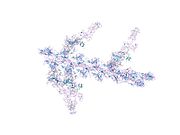 1m8q: Molecular Models of Averaged Rigor Crossbridges from Tomograms of Insect Flight Muscle
1m8q: Molecular Models of Averaged Rigor Crossbridges from Tomograms of Insect Flight Muscle -
 1mvw: MOLECULAR MODELS OF AVERAGED RIGOR CROSSBRIDGES FROM TOMOGRAMS OF INSECT FLIGHT MUSCLE
1mvw: MOLECULAR MODELS OF AVERAGED RIGOR CROSSBRIDGES FROM TOMOGRAMS OF INSECT FLIGHT MUSCLE -
 1o18: MOLECULAR MODELS OF AVERAGED RIGOR CROSSBRIDGES FROM TOMOGRAMS OF INSECT FLIGHT MUSCLE
1o18: MOLECULAR MODELS OF AVERAGED RIGOR CROSSBRIDGES FROM TOMOGRAMS OF INSECT FLIGHT MUSCLE -
 1o19: MOLECULAR MODELS OF AVERAGED RIGOR CROSSBRIDGES FROM TOMOGRAMS OF INSECT FLIGHT MUSCLE
1o19: MOLECULAR MODELS OF AVERAGED RIGOR CROSSBRIDGES FROM TOMOGRAMS OF INSECT FLIGHT MUSCLE -
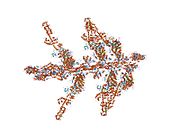 1o1a: MOLECULAR MODELS OF AVERAGED RIGOR CROSSBRIDGES FROM TOMOGRAMS OF INSECT FLIGHT MUSCLE
1o1a: MOLECULAR MODELS OF AVERAGED RIGOR CROSSBRIDGES FROM TOMOGRAMS OF INSECT FLIGHT MUSCLE -
 1o1b: MOLECULAR MODELS OF AVERAGED RIGOR CROSSBRIDGES FROM TOMOGRAMS OF INSECT FLIGHT MUSCLE
1o1b: MOLECULAR MODELS OF AVERAGED RIGOR CROSSBRIDGES FROM TOMOGRAMS OF INSECT FLIGHT MUSCLE -
 1o1c: MOLECULAR MODELS OF AVERAGED RIGOR CROSSBRIDGES FROM TOMOGRAMS OF INSECT FLIGHT MUSCLE
1o1c: MOLECULAR MODELS OF AVERAGED RIGOR CROSSBRIDGES FROM TOMOGRAMS OF INSECT FLIGHT MUSCLE -
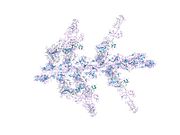 1o1d: MOLECULAR MODELS OF AVERAGED RIGOR CROSSBRIDGES FROM TOMOGRAMS OF INSECT FLIGHT MUSCLE
1o1d: MOLECULAR MODELS OF AVERAGED RIGOR CROSSBRIDGES FROM TOMOGRAMS OF INSECT FLIGHT MUSCLE -
 1o1e: MOLECULAR MODELS OF AVERAGED RIGOR CROSSBRIDGES FROM TOMOGRAMS OF INSECT FLIGHT MUSCLE
1o1e: MOLECULAR MODELS OF AVERAGED RIGOR CROSSBRIDGES FROM TOMOGRAMS OF INSECT FLIGHT MUSCLE -
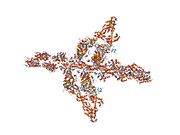 1o1f: MOLECULAR MODELS OF AVERAGED RIGOR CROSSBRIDGES FROM TOMOGRAMS OF INSECT FLIGHT MUSCLE
1o1f: MOLECULAR MODELS OF AVERAGED RIGOR CROSSBRIDGES FROM TOMOGRAMS OF INSECT FLIGHT MUSCLE -
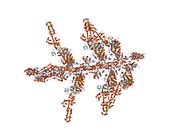 1o1g: MOLECULAR MODELS OF AVERAGED RIGOR CROSSBRIDGES FROM TOMOGRAMS OF INSECT FLIGHT MUSCLE
1o1g: MOLECULAR MODELS OF AVERAGED RIGOR CROSSBRIDGES FROM TOMOGRAMS OF INSECT FLIGHT MUSCLE
 | This article on a gene on human chromosome 17 is a stub. You can help Wikipedia by expanding it. |
- v
- t
- e






























